The Enthusiast is a reader-supported publication. If you enjoy what you’re reading here, why not subscribe? You’ll enjoy free articles, join a community of defiant praise, and get access to recommendations, playlists, and invigorating chats.
One of the first paintings by San Francisco artist Joan Brown I ever saw was called Man & Tiger, a canvas depicting a tiger with a man’s head reclining across a flat, speckled blue background. The human head has plain features framed in soft black locks. He looks a bit like Donny Osmond, though this painting predates Donny’s teen idolship by about five years. He appears to be gazing at an upright figure of a man, arms crossed over his chest, capped with the head of a tiger taking up the left third of the composition.
The tiger’s head looks like a tiger, though its open mouth and yellow eyes lack the predatory directness of tiger tigers. It looks like it’s in the middle of saying something — not a roar, rather a quippy remark, a sassy chide. Its posture is somewhat aloof, fashionable. The tiger-man is ready to party, down-to-clown. The man-tiger comes off as more reserved, laid-back because he is laid back, set back, perhaps a bit dazed. I picked up a sense of longing in his eyes. Something happened here. A wish granted. A fever dream. Which would I rather be? The man-tiger, or the tiger-man? In pursuit of answers, I wrote a poem from the perspective of the man-tiger in which he weighs the decision he made to swap his body for that of a tiger. He does not regret the “forever stripes” that he now wore, but he can not help but mourn the fact that he would never be able to change them, that he would never again wear his favorite shirt… “the one covered in little smiles of moon.”
I don’t know about the overall quality of the poem, but I do like that last line. Writing it, reading it again, I feel as I imagine the Tiger-Man feels. A proud air wafts off his shoulders. Maybe he is the poet and the Man-Tiger is the poem. Two linked forms, yet decidedly separate. A sphinx and his riddle that loosens with the right tugs but never fully gives in and unties.
Daniel Tiger has taught me this: sometimes we feel two things at the same time. Joan Brown’s Man & Tiger, this: Sometimes we are two things — or more — at the same time.
These creatures, common features of Joan Brown’s later work, play with hybridity. Change and transformation and mish-mashed forms. Yes, they are in one sense goofy. A cat “mask” on the body of a woman in her underwear, a cat in a wedding dress posing in front of a river of fish, half a woman and half a cat halved down their middles and shoved together. Like other mythic beasts, these things are so blatant and bold that they can’t not be interpreted. The pet cat started to appear as its more wild cousin as Brown’s aesthetics shifted to that of ancient and religious symbols. But the nature of the beast didn’t change. Tiger or tabby, the cat is always Joan Brown — varying forms to represent the complexity of one’s spirit.
Keep reading with a 7-day free trial
Subscribe to The Enthusiast to keep reading this post and get 7 days of free access to the full post archives.





